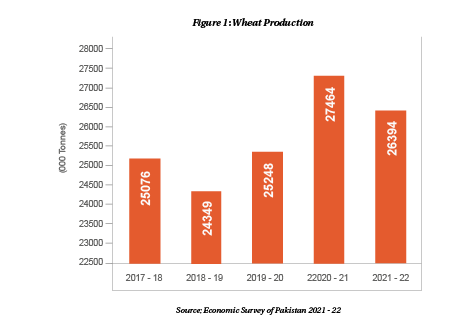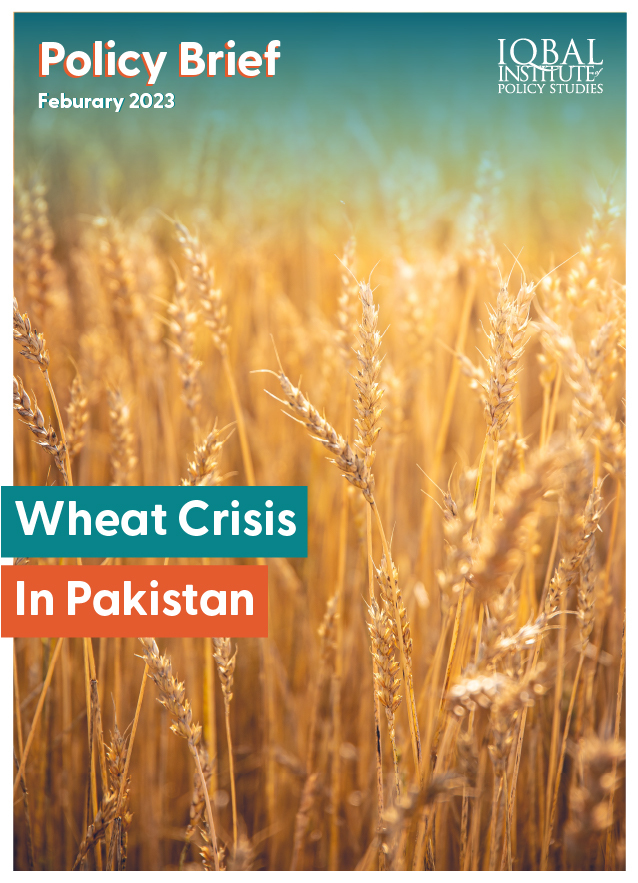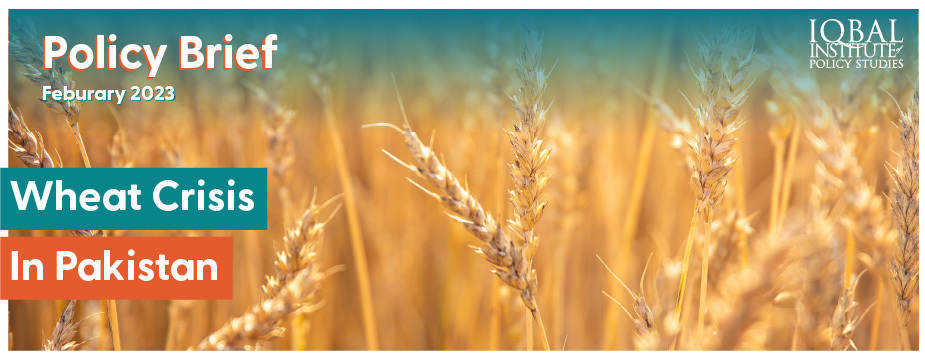The agricultural sector is the backbone of Pakistan’s economy. According to the Economic Survey of Pakistan, it contributed 22.7% to the economy’s GDP in 2022. It employs 37.4% of the labour force. This is the main source of providing food for the people. Wheat is considered one of the vital crops for maintaining a healthy diet and dietary staple. It accounts for 7.8 % of value addition in agriculture and 1.8% of the GDP (GoP, 2021-22). Wheat production has declined from 27,464 tonnes in 2021 to 26,394 tonnes in 2022. Nonetheless, the cultivation area and yield of the wheat crop have been decreasing continuously in the last four years except in 2021, when the yield was slightly high.
 The self-sufficiency to fulfil the demand for wheat in the country is the primary objective of each incumbent government. It has become challenging for agricultural experts and policymakers to suggest practical and cost-efficient solutions to meet demand. Pakistan Agriculture Research Council (PARC) estimates that per capita consumption of wheat at 125 kg per annum as a grain makes up an average of 60% of the daily diet of an ordinary citizen (Mahmood, 2021). It shows that most of our population is dependent on wheat, and its deficiency creates an awkward situation that will lead to political uncertainty, massive drainage of foreign reserves, and a rise in the price of wheat. Moreover, to fulfill the need for wheat government has to import it from other countries. Currently, the government is importing 750,000 tonnes of wheat from Russia (Donley, 2023). There are various reasons for the shortage of wheat, such as a decline in arable areas, poor irrigation systems, environmental factors, etc.
The self-sufficiency to fulfil the demand for wheat in the country is the primary objective of each incumbent government. It has become challenging for agricultural experts and policymakers to suggest practical and cost-efficient solutions to meet demand. Pakistan Agriculture Research Council (PARC) estimates that per capita consumption of wheat at 125 kg per annum as a grain makes up an average of 60% of the daily diet of an ordinary citizen (Mahmood, 2021). It shows that most of our population is dependent on wheat, and its deficiency creates an awkward situation that will lead to political uncertainty, massive drainage of foreign reserves, and a rise in the price of wheat. Moreover, to fulfill the need for wheat government has to import it from other countries. Currently, the government is importing 750,000 tonnes of wheat from Russia (Donley, 2023). There are various reasons for the shortage of wheat, such as a decline in arable areas, poor irrigation systems, environmental factors, etc.
Drivers of Wheat Crises
Increase in Inflation
Inflation is harmful to the growth of the country’s economy. An increase in price means money can buy fewer products and reduce the purchasing power of consumers. The increase in the price of inputs leads to an increase in output price. As shown in the graph, food inflation in Pakistan is increasing. It was 15.5% in March compared to 35% in December 2022.
 The Sensitive Price Index (SPI) monitors the price of 51 essential items across 17 cities in Pakistan. On a year-on-year basis, wheat prices have increased to 46.38 % (GoP, 2023). The price of wheat after the minimum support price was Rs 2,200 in 2021, and it grew to Rs 3,900 per maund in December 2022 (Daily Times, 2022).
The Sensitive Price Index (SPI) monitors the price of 51 essential items across 17 cities in Pakistan. On a year-on-year basis, wheat prices have increased to 46.38 % (GoP, 2023). The price of wheat after the minimum support price was Rs 2,200 in 2021, and it grew to Rs 3,900 per maund in December 2022 (Daily Times, 2022).
Food Pricing Policy
In Pakistan, the food pricing policy consists of input subsidies and price support mechanisms. These tools have negative implications, such as
If these are set below the equilibrium price, there will be a food shortage, and if above that, it will cause a food surplus.
Foreign investors will be reluctant to invest as it affects their profits.
It may increase inequality as powerful peasants will get more benefits compared to the low-income profile farmers.
If the government provides subsidies on one crop, i.e., vegetables and fruits. Farmers will not prefer to sow other crops (Fatima, 2022).
Difference Between Farm Gate Price and DCO Price
The farm gate prices are, in principle, the prices received by farmers for commodities they produce at the farm’s location. The DCO price is set by the District Coordinator Officer (DCO). In Pakistan, there is an average 10.5% difference in DCO and farm gate price (its variation ranges between 6.3% to 20.3%). This means that the DCO price is impractical and irrational. Thus, it is not implemented anywhere in Pakistan as it is difficult for the retailer to sell a food item below the price they are receiving (as labour and transportation costs are also included) (Fatima, 2022).
Minimum Support Price
As wheat is one of the essential grains, the Government of Pakistan (GoP) is continuously intervening in the wheat market. It purchases 70% of the marketable surplus at Minimum Support Price (MSP). The MSP is defined as ‘the minimum price set by the government for certain agricultural products, at which the products would directly be brought from the farmers if the open market prices are less than the cost incurred’. Though the increase in the price of wheat is due to inflation, fixing the high MSP of wheat also contributes to surging inflation.
As per the analysis, the MSP benchmark was not equal to the cost of production in the last four years, as shown in the table, decreasing the profit margin for the wheat grower. Therefore, wheat farmers are the victims of inflation. On the contrary, comparing with other crops such as rice, maize, and cotton has demonstrated that the farmers’ profitability has increased, implying that inflation has increased their benefits. It is because the price of the crops will be adjusted automatically through a market mechanism, which adjusts the inflationary gap while not in the case of wheat (Ajum, 2022).

Environment Factor
The floods in 2022 have affected the agriculture sector adversely. It resulted in the loss and damage to inputs such as fertilisers, stocks, machinery at the household level, and irrigation infrastructure, which may reduce the area for the plantation of crops and affect the crop development process. According to the United States Department of Agriculture (USDA), floods have negatively impacted the wheat plantation area. Only Sindh province is planting wheat in 20% of its arable land, and most of its land is submerged due to floods. It was predicted that the seeding of the wheat crop would be delayed, and some parts of the land would remain unseeded. The purchasing power of the farmers is low, making it difficult for them to buy fertilisers and seeds (The News, 2022).
Unstable International Market
The uncertain geopolitical situation has increased the wheat price. For instance, Pakistan was importing 39% of its wheat from Ukraine. The war between Russia and Ukraine has distorted wheat imports not only in Pakistan but around the world. Hence, wheat price in the international market has increased by up to 60% (RSIL, 2022).
Provincial Fragmentation
After the amendment in Constitution Act, commonly known as the 18th amendment, “the prime responsibility of price management vests with provincial bodies”. But coordination among all departments for a stable supply chain and price stability is challenging, so controlling inflation will become more difficult. Nonetheless, the continuous political fragmentation and crippling economic conditions increase the price of wheat between Rs 140-160 per kilogram (Bhukhari et al., 2023).
Wheat Hoarders
The wheat crisis occurred due to hoarding wheat stock. The provincial government is unable to take strict action against hoarders. Nonetheless, the government is making efforts to sell bags from dedicated points and utility stores. Few people reach those points due to long distances and high transportation costs.
On the other hand, due to the unavailability of accurate data, the government needs to take the right decision to export wheat, i.e., in the fiscal year 2019-20, which triggered the wheat crisis. The provincial government should refill its stock hastily once the harvest is completed. Delays in taking decisions give opportunities to hoarders and rent-seekers, which leads to a wheat crisis (Bhukhari et al., 2023).
Poor Quality of Inputs
One of the reasons for the low production of wheat is the sowing of poor-quality seeds. The country has only 46% of certified seeds and wheat cultivated over 25 million acres. The government and some private sector entities own 1.1 million tonnes of certified wheat seed. The country lacked about 54 per cent of quality seed, which resulted in a decrease in the production of wheat (Daily Times, 2022).
Recommendation
The government should ensure wheat’s availability at affordable prices and make efforts to address the underlying causes of the shortages, such as transportation and storage issues.
The yield per acre can be improved by expanding the areas for cultivation and introducing modern techniques/processes for farmers.
An Integrated approach should be followed to make policies and precautionary measures to protect the country from the wheat shortage.
All the tiers of government, either national or local, should collaborate and empower farmers to adopt efficient means to produce wheat by providing them with training, resources, and access to modern technologies/processes.
Farmers should be provided with diesel and electricity at reasonable prices and certified seeds.
The imported wheat should be distributed equally among all provinces.
Government can use the social protection program Benazir Income Support Programme (BISP) to disburse flour bags at subsidised rates.
Government should allow market forces to adjust the cost surge of wheat automatically.
References
Ajum, A. (2022). Does Fixing High Minimum Support Price (MSP) for Wheat a Source of Inflation or High Prices Itself a Victim of Inflation? Pakistan Institute of Development Studies.
Bhukhari et al. (2023, January). Wheat Crisis. Retrieved from Business Recorder: https://www.brecorder.com/news/40221321
Daily Times. (2022, December 12). Wheat price reaches all-time high in Pakistan. Retrieved from Daily Times: https://dailytimes.com.pk/1038580/wheat-price-reaches-all-time-high-in-pakistan/
Daily Times. (2022, October). Lack of awareness and poor quality seed cause low wheat production. Retrieved from Daily Times: https://dailytimes.com.pk/1012100/lack-of-awareness-poor-quality-seed-cause-low-wheat-production/
Donley, A. (2023, January). Flour crisis worsening in Pakistan. Retrieved from World Grain: https://www.world-grain.com/articles/17960-flour-crisis-worsening-in-pakistan
Fatima, A. (2022). Food Pricing Policy In Pakistan. Pakistan Institute of Development Economics.
GoP. (2021-22). Chapter 2 Agriculture. Ministry of Finance.
Mahmood, A. (2021, May 27). Despite bumper wheat crop Pakistan still needs to be food secure. Retrieved from Dawn: https://www.dawn.com/news/1625954
RSIL. (2022). The War in Ukraine and the Potential Impact on Pakistans Trade. Retrieved from Research Society of International Law: https://rsilpak.org/2022/the-war-in-ukraine-and-the-potential-impact-on-pakistans-trade/
The News. (2022, October). High input costs, floods dampen the FY23 wheat outlook. Retrieved from The News: https://www.thenews.com.pk/print/997428-high-input-cost-floods-dampen-fy23-wheat-outlook



Leave a Reply